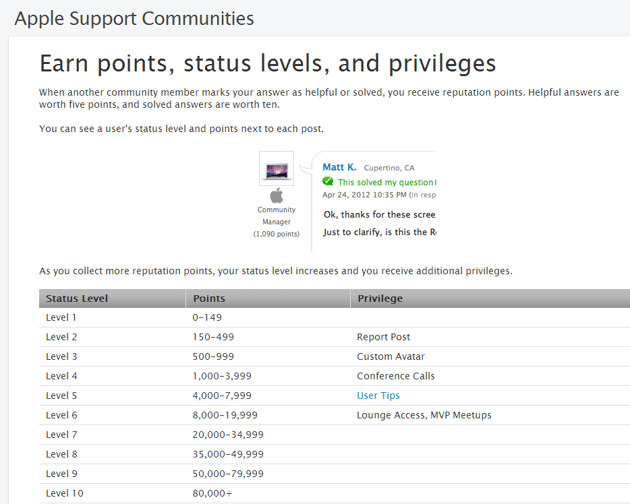How to Drive Engagement like the Big Guys

Brands spend a lot of time "engaging" their customers on social channels nowadays, but just because fans like brands or retweet posts, doesn't mean that they are actually engaged.
This poses a problem for businesses, as keeping audiences engaged typically results in customers that are more loyal, a boost in repeat customers and better word-of-mouth advertising. In fact, many of the top brands on the 'Net foster online communities to keep customers engaged with their businesses on a regular basis. Take the following brands as examples:
NFL
Community Strategy: Gamification
It is hard to find a more active fan base than the NFL's whose fans have a variety of ways to stay engaged with the football brand. In addition to the cult classic online game Fantasy Football, the NFL incorporated gamification elements onto its site that reward site members with "coins" and "points" based on actions they take, such as reading articles or liking the brand on social channels. Rewards can be cashed in for prizes in the site's rewards store. Conversely, the points are part of a site-wide engagement competition, in which the NFL ranks its members on a public leaderboard.

Pampers
Community Strategy: Loyalty
The "Pampers Village" provides articles, tips and tools for moms and moms-to-be. In addition, the community enables members to earn points through a rewards system that can be redeemed for toys, gift cards and other prizes. Members can earn points by purchasing diapers and wipes each month. However, in order to promote brand loyalty, products must be purchased in consecutive months, as members receive gifts for purchasing Pampers products 3, 6, 9 or 12 months in a row - meaning that if you miss a month, you must start over.

Apple
Community Strategy: Forums
You've probably heard of Apple "fan boys" and "fan girls", and while some may use this term condescendingly, the truth is Apple has worked hard to build an audience base full of dedicated fans. To keep these fans happy, Apple not only needs to keep coming out with innovative products, but must also provide superior customer service. Part of the way Apple accomplishes the latter is through "Support Communities" on its website. These communities enable customers to ask questions and reply to others' queries. Plus, when members get their answers marked as "helpful" or "solved" by other community members, they receive reputation points, and as users collect more reputation points, their status level increases and they receive additional privileges, such as custom avatars or MVP Meetups.

Luckily, the big guys aren't the only ones able to build online communities. In fact, the Web is full of technologies that any business can leverage to incorporate gamification, loyalty programs or even forums into their sites. Consider the five platforms below:
The Vanilla platform offers both cloud and open source community forum software that brands can leverage to power discussions on their sites. In fact, this platform is already leveraged by more than 670,000 sites on the Web, including HubSpot and XO Group. The platform not only hosts conversations, but also attracts new users, is customizable and includes a variety of engaging features such as a "Best of" page and the ability for members to earn badges based on participation.
2. Badgeville
The Badgeville Behavior Platform enables businesses to reward customers that interact with their websites, communities or social media channels. The platform can be leveraged to provide site members with contextual rewards based on customer interactions, to implement customer "missions" (larger achievements) and to offer rewards based on social activity, as well as to incorporate a point system, categorize members by "levels" and even to display leaderboards, much like the NFL.
3. 500friends
Expand your existing loyalty program with the LoylatyPlus Amplify solution from 500friends. The company's white-label browser extension allows members to earn loyalty currency whenever they shop online. Points are earned not only on merchant sites within the 500friends' loyalty network, but also through leading search engines. This means that merchants can stay top-of-mind even as consumers shop on different sites. Plus, since members earn rewards faster, merchants tend to see more conversions on their sites.
4. Ning
Launch your very own social network with Ning. This platform enables brands to build their own community, which can be added to existing sites to increase engagement. Ning, which started six years ago, powers 2 million communities on the Web. Brands have the ability to customize their communities, and since Ning utilizes responsive design and HTML5, communities are also accessible on mobile devices. In addition, brands get complete access to membership data, can choose to keep their communities public or private and even have the ability to choose social sign-in as a member signup option.
5. Needle
Although this platform is a bit different from the aforementioned options, it still can help brands foster engagement with their audiences. This is because Needle taps into a brand's existing audience and trains top fans to sell its products and services. These "expert" fans use interactive tools to make personal connects and custom recommendations to other shoppers. Moreover, since these expert fans are actual consumers, they tend to be more relatable and trustworthy, which helps brands boost their conversion rates and average order values (AOV).










